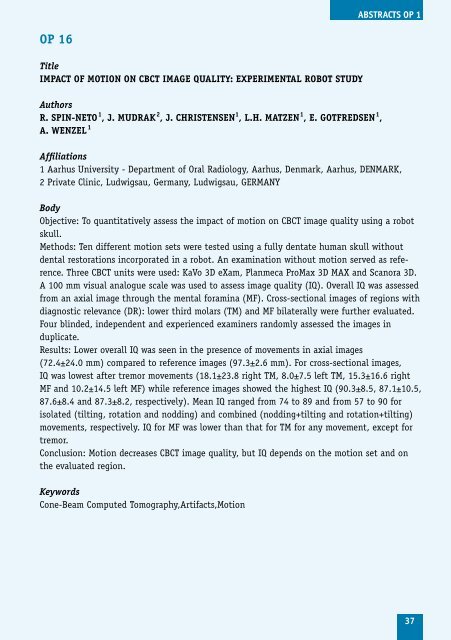Program including abstracts as pdf available here
Program including abstracts as pdf available here
Program including abstracts as pdf available here
You also want an ePaper? Increase the reach of your titles
YUMPU automatically turns print PDFs into web optimized ePapers that Google loves.
OP 16<br />
Title<br />
IMPACT OF MOTION ON CbCT IMAGE QuALITy: EXPERIMENTAL RObOT STuDy<br />
Authors<br />
R. SPIN-NETO 1 , J. MuDRAK 2 , J. CHRISTENSEN 1 , L.H. MATzEN 1 , E. GOTFREDSEN 1 ,<br />
A. WENzEL 1<br />
Affiliations<br />
1 Aarhus University - Department of Oral Radiology, Aarhus, Denmark, Aarhus, DENMARK,<br />
2 Private Clinic, Ludwigsau, Germany, Ludwigsau, GERMANY<br />
Body<br />
Objective: To quantitatively <strong>as</strong>sess the impact of motion on CBCT image quality using a robot<br />
skull.<br />
Methods: Ten different motion sets were tested using a fully dentate human skull without<br />
dental restorations incorporated in a robot. An examination without motion served <strong>as</strong> reference.<br />
Three CBCT units were used: KaVo 3D eXam, Planmeca ProMax 3D MAX and Scanora 3D.<br />
A 100 mm visual analogue scale w<strong>as</strong> used to <strong>as</strong>sess image quality (IQ). Overall IQ w<strong>as</strong> <strong>as</strong>sessed<br />
from an axial image through the mental foramina (MF). Cross-sectional images of regions with<br />
diagnostic relevance (DR): lower third molars (TM) and MF bilaterally were further evaluated.<br />
Four blinded, independent and experienced examiners randomly <strong>as</strong>sessed the images in<br />
duplicate.<br />
Results: Lower overall IQ w<strong>as</strong> seen in the presence of movements in axial images<br />
(72.4±24.0 mm) compared to reference images (97.3±2.6 mm). For cross-sectional images,<br />
IQ w<strong>as</strong> lowest after tremor movements (18.1±23.8 right TM, 8.0±7.5 left TM, 15.3±16.6 right<br />
MF and 10.2±14.5 left MF) while reference images showed the highest IQ (90.3±8.5, 87.1±10.5,<br />
87.6±8.4 and 87.3±8.2, respectively). Mean IQ ranged from 74 to 89 and from 57 to 90 for<br />
isolated (tilting, rotation and nodding) and combined (nodding+tilting and rotation+tilting)<br />
movements, respectively. IQ for MF w<strong>as</strong> lower than that for TM for any movement, except for<br />
tremor.<br />
Conclusion: Motion decre<strong>as</strong>es CBCT image quality, but IQ depends on the motion set and on<br />
the evaluated region.<br />
Keywords<br />
Cone-Beam Computed Tomography,Artifacts,Motion<br />
aBSTracTS OP 1<br />
37


